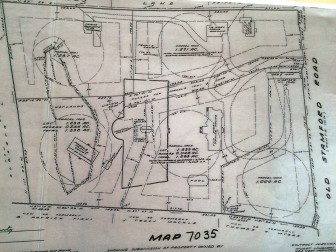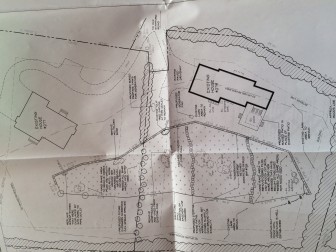Officials are at odds with an Old Stamford Road man who’s asking that references to violations of New Canaan’s Inland Wetlands and Watercourses Regulations be removed from a proposed new land record with his name on it.

A map of 277 and 279 Old Stamford Road shows the designated wetlands area.
No one disagrees that the clearing of a large wetlands area at 279 Old Stamford Road amounts to a violation of those regulations, and an existing conservation easement for the property had specifically noted “no disturbance, no maintenance, no planting,” according to a public record of last month’s Inland Wetlands Commission meeting.
Commissioners did grant Cullis a wetlands permit in order to start restoration work of the area—the plan now is to reseed the cleared area as a meadow—but one condition of that approval is that the Inland Wetlands Commission sign off on the new conservation easement that will be recorded with the Town Clerk.
Two sections in a draft of that conservation easement read:
- “WHEREAS, in violation of the terms of the Original Conservation Easement, Culliss performed certain prohibited acts within the Original Conservation Easement area, including the Conservation Easement area on [a neighbor’s] property.”
- “WHEREAS, Grantor has applied to the Inland Wetlands Commission of the Town of New Canaan (successor to the Environmental Commission of the Town of New Canaan) to conduct certain activities within the Conservation Easement area, including restoration and mitigation to remedy the violations.”
According to Cullis, the references to violations are “simply not necessary.”
“It [the draft ‘Revised Conservation Easement’] says that there is a permit that needs to be executed upon and that this needs to be changed to allow it,” Cullis told commissioners at their regular monthly meeting, held at Town Hall.
He added that, based on successively updated versions of the draft document going back-and-forth between him and the town, he had thought his elimination of the references to violations had gone through.
“It is not clear who is providing opinion that that has to be in there, but ‘Whereas’ clauses in contracts are not that critical,” Cullis said. “There is already consideration, there is already explanation as to why this is being done. It’s really superfluous. It’s just not needed. And yes, that is an opinion, but I think you could ask other people, other attorneys, and get the same opinion.”
Later in the meeting, commissioner Peggy Kirby said the record of the violation probably represents “a black mark against your name” for Cullis and that he probably didn’t “want it on the easement that you violated” the local regulations.
Cullis nodded and said: “That certainly makes sense.”
Inland Wetlands officials said town attorney Ira Bloom and especially Peter Gelderman of the same firm—Westport’s Berchem, Moses & Devlin P.C.—had been advising on the matter and purposely inserted the ‘Whereas’ clauses that refer to violations. They also said that, by the time the remediation process plays out, a statement will be issued saying Cullis is 100 percent in compliance with regulations.
Inland Wetlands Commission Chairman Daniel Stepanek added that it is important for anyone reviewing land records to understand why the new conservation easement was developed at all.
“The title of this is ‘Revised Conservation Easement,’ ” he said. “Where does it explain except this ‘Whereas’ that you want crossed out? Why we are revising it? That’s what I am asking. Where does it explain why we have to revise it?”
Cullis answered: “Because there has been a permit granted and the easement needs to be changed to allow the activities to take place.”
The reference in the draft easement is made to a next-door neighbor, at 277 Old Stamford Road, because the wetlands area cleared—and this work was done without a permit by Mike Nolan of Mt. Kisco, N.Y., officials have said, a landscaper who maintains other properties in New Canaan—straddles the property line with number 279.
Ultimately, the commission decided to ask Bloom to come to its next meeting to explain the references to the violations in the proposed conservation easement.
“We are at an impasse here,” Stepanek said.
Commissioners said they intended to contact Nolan directly and instruct him to attend the next meeting since he missed Monday’s—for a pre-planned trout fishing trip in New Jersey, Cullis said (the Garden State’s season goes through Dec. 31).
“Tell [Nolan] he is not off the hook,” Stepanek said to Cullis.
In discussing the violations on Old Stamford Road last month, commissioners voiced concern about landscapers who ignore regulations and then point the finger at unknowing homeowners.
Also at that meeting, Culliss, together with Kate Throckmorton, landscape architect at Norwalk-based Environmental Land Solutions, introduced a restoration plan that includes continued removal of multi flora rose, honeysuckle and vines, and planting meadow grass in the wetlands and setback area around it.

Site plan for the restricted wetlands area that straddles 277 and 279 Old Stamford Road.
Plans also call for the planting of 14 evergreen trees to separate Culliss’s property from the neighbor (who appears not to have known the clearing was happening), as well as installation of a generator pad, and propane tank, expansion of existing patio behind the house and creation of two paths so that people and pets can walk around it. Cullis told commissioners last month that he hadn’t been aware of the conservation easement and that a reason for removing invasive plants from the area was that the thorns and poison ivy in it were not good for his four young children.
The clearing itself appears to have started in the spring, though by the time Inland Wetlands officials discovered it this fall, the area had been completely weeded and was being smoothed over with a backhoe, according to the Oct. 19 meeting minutes.
Stepanek toward the end of the meeting asked Cullis whether he was “adamant” about removing the references to violations.
Cullis answered: “Let’s put it this way: If I thought at all that it was legally significant, I would leave it in. I think it is completely unnecessary and I just feel 100 percent certain about that based on my background and education, and I really don’t see a reason for it to be there. So this negotiation I think was unfortunately very fast, this discussion about this document, and I think I want a little bit more time to consider the absolute requirements.”
The commission’s next meeting is scheduled for Dec. 21.
